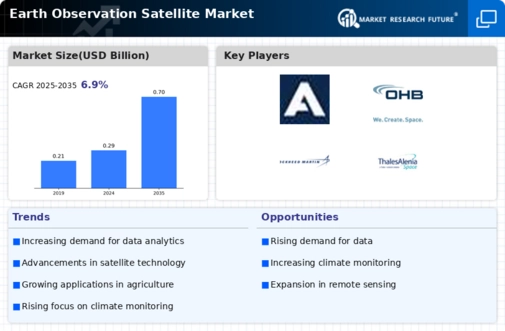Market Analysis
Earth Observation Satellite Market (Global, 2024)
Introduction
The Earth Observation Satellite Market is poised to play a pivotal role in the ongoing transformation of how we monitor and manage our planet's resources and environment. As technological advancements continue to enhance satellite capabilities, the demand for high-resolution imagery and data analytics is surging across various sectors, including agriculture, urban planning, disaster management, and climate research. The integration of artificial intelligence and machine learning with satellite data is further revolutionizing the way insights are derived, enabling more informed decision-making processes. Additionally, the increasing emphasis on sustainability and environmental conservation is driving investments in satellite technologies that can provide critical information for tracking changes in land use, deforestation, and natural disasters. As stakeholders from government agencies to private enterprises recognize the value of Earth observation data, the market is witnessing a dynamic evolution characterized by innovation, collaboration, and a growing ecosystem of service providers and end-users.
PESTLE Analysis
- Political
- In 2024, the Earth Observation Satellite Market is heavily influenced by government policies and international agreements aimed at enhancing space exploration and satellite deployment. The U.S. government allocated approximately $1.5 billion for Earth observation programs under the National Oceanic and Atmospheric Administration (NOAA) budget, reflecting a commitment to improving climate monitoring and disaster response capabilities. Additionally, the European Space Agency (ESA) has initiated the Copernicus program with a budget of €10 billion, focusing on environmental monitoring and sustainable development, which underscores the political will to leverage satellite technology for public good.
- Economic
- The economic landscape for the Earth Observation Satellite Market in 2024 is characterized by increased investment in satellite technology and services. The global satellite manufacturing industry is projected to generate revenues of around $20 billion, driven by demand for high-resolution imagery and data analytics. Furthermore, the commercial sector is expected to contribute approximately $8 billion to the market, as businesses increasingly rely on satellite data for applications in agriculture, urban planning, and resource management, highlighting the economic potential of this sector.
- Social
- Social factors are playing a crucial role in the Earth Observation Satellite Market, particularly in terms of public awareness and demand for transparency in environmental monitoring. In 2024, surveys indicate that 75% of the population in developed countries are concerned about climate change and support the use of satellite data for tracking environmental changes. This growing public interest is pushing governments and organizations to invest in satellite technologies that provide real-time data on climate conditions, natural disasters, and urban development, thereby enhancing societal resilience and awareness.
- Technological
- Technological advancements are rapidly transforming the Earth Observation Satellite Market in 2024. The deployment of small satellites, or CubeSats, has surged, with over 1,000 CubeSats launched in the past year alone, enabling cost-effective and frequent data collection. Additionally, the integration of artificial intelligence and machine learning in data processing is expected to improve the accuracy of satellite imagery analysis by up to 30%, allowing for more precise applications in agriculture, forestry, and disaster management, thus driving innovation in the sector.
- Legal
- Legal frameworks governing the Earth Observation Satellite Market are evolving to address issues related to data privacy, airspace regulation, and international treaties. In 2024, the United Nations Office for Outer Space Affairs reported that 120 countries have ratified the Outer Space Treaty, which governs the use of outer space and satellite operations. Furthermore, new regulations are being developed to ensure compliance with data protection laws, particularly in the European Union, where the General Data Protection Regulation (GDPR) impacts how satellite data is collected and used, emphasizing the need for legal compliance in satellite operations.
- Environmental
- Environmental considerations are increasingly shaping the Earth Observation Satellite Market, particularly in the context of climate change and sustainability. In 2024, it is estimated that satellite data will be crucial for monitoring over 1,000 environmental indicators, including deforestation rates, water quality, and greenhouse gas emissions. The use of Earth observation data is expected to support global efforts to achieve the United Nations Sustainable Development Goals (SDGs), with a focus on responsible consumption and production patterns, thereby highlighting the environmental impact and responsibility of satellite technologies.
Porter's Five Forces
- Threat of New Entrants
- Medium - The Earth Observation Satellite Market has moderate barriers to entry due to the high capital investment required for satellite technology and infrastructure. However, advancements in technology and the emergence of small satellite manufacturers have lowered some entry barriers, allowing new players to enter the market more easily. This creates a competitive environment but also means that established companies must continuously innovate to maintain their market position.
- Bargaining Power of Suppliers
- Low - The bargaining power of suppliers in the Earth Observation Satellite Market is relatively low. The market relies on a variety of components and technologies, many of which are sourced from multiple suppliers. This diversification reduces the power of any single supplier. Additionally, as the market grows, more suppliers are likely to enter, further diminishing their bargaining power.
- Bargaining Power of Buyers
- High - Buyers in the Earth Observation Satellite Market have high bargaining power due to the increasing availability of satellite data and services from multiple providers. As more companies and governments seek satellite imagery for various applications, they can easily switch between providers, which forces companies to offer competitive pricing and enhanced services to retain customers.
- Threat of Substitutes
- Medium - The threat of substitutes in the Earth Observation Satellite Market is medium. While satellite imagery is unique in its capabilities, alternative data sources such as aerial imagery, drones, and ground-based sensors can serve similar purposes in certain applications. However, the comprehensive and global coverage provided by satellites remains unmatched, which limits the overall threat from substitutes.
- Competitive Rivalry
- High - Competitive rivalry in the Earth Observation Satellite Market is high, driven by the presence of numerous established players and new entrants. Companies are competing on technology, pricing, and service offerings to capture market share. The rapid pace of technological advancements and the growing demand for satellite data further intensify competition, leading to continuous innovation and strategic partnerships among firms.
SWOT Analysis
Strengths
- Advanced technology enabling high-resolution imaging and data collection.
- Growing demand for environmental monitoring and disaster management.
- Strong government and private sector investment in satellite technology.
Weaknesses
- High initial costs associated with satellite development and launch.
- Limited lifespan of satellites leading to frequent replacements.
- Dependence on weather conditions for data accuracy and reliability.
Opportunities
- Expansion of applications in agriculture, urban planning, and climate change monitoring.
- Emerging markets showing increased interest in satellite data utilization.
- Advancements in AI and machine learning enhancing data analysis capabilities.
Threats
- Intense competition among satellite manufacturers and service providers.
- Regulatory challenges and geopolitical tensions affecting satellite operations.
- Potential for space debris and its impact on satellite functionality.
Summary
The Earth Observation Satellite Market in 2024 is characterized by advanced technology and strong investment, positioning it well to meet the growing demand for environmental monitoring. However, high costs and limited satellite lifespans present challenges. Opportunities lie in expanding applications and emerging markets, while competition and regulatory issues pose significant threats. Strategic focus on innovation and collaboration will be essential for market players to navigate these dynamics.


















Leave a Comment